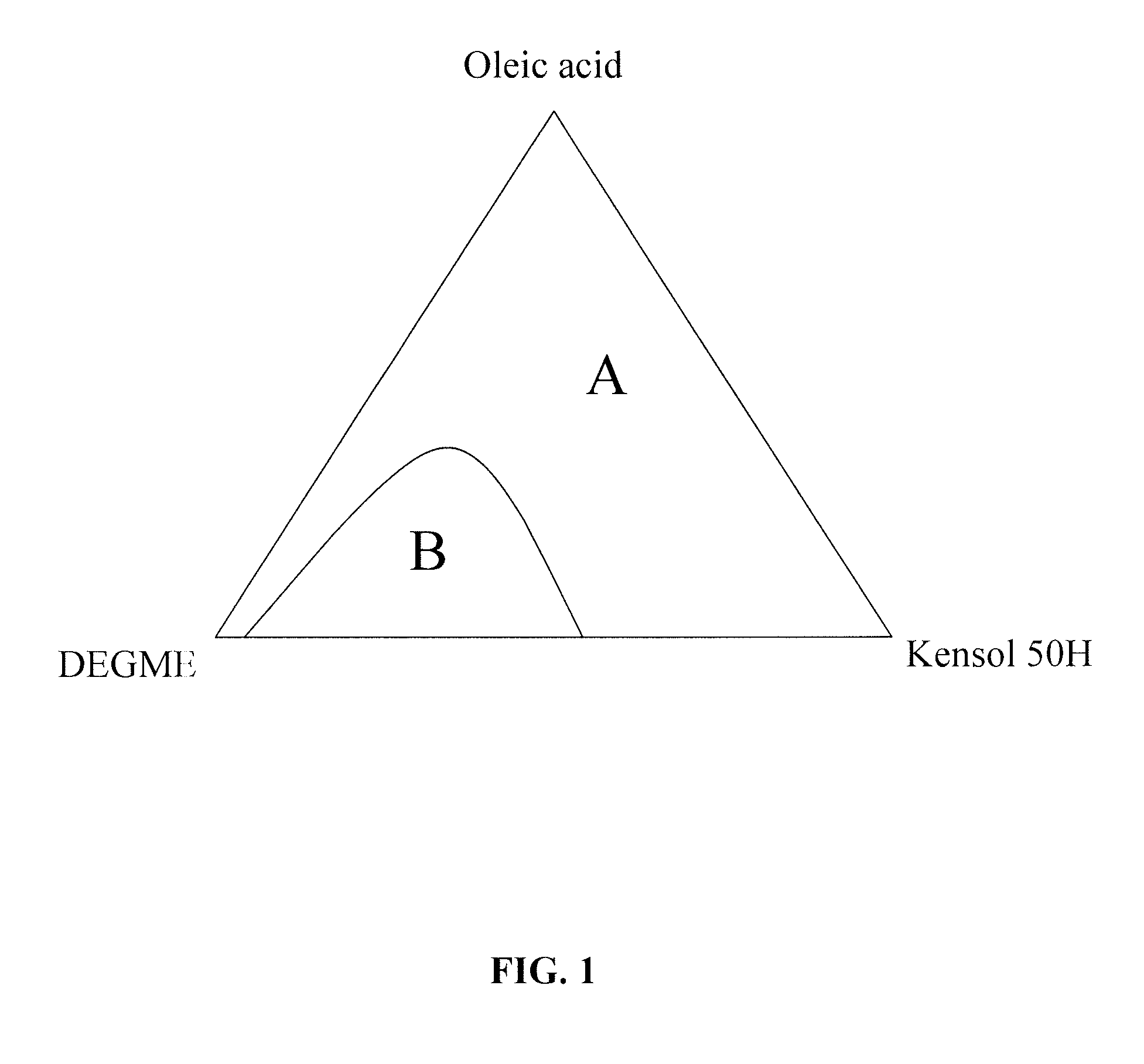Rapid method for production of cerium-containing oxide organic colloids
a cerium-containing oxide and organic colloids technology, applied in the field of colloidal nanoparticle dispersions, can solve the problems of high cost of conventional aqueous processes, inability to stabilize in a non-polar environment, and the agglomeration of particles, etc., and achieves the effect of simple, rapid and low temperature processes
- Summary
- Abstract
- Description
- Claims
- Application Information
AI Technical Summary
Benefits of technology
Problems solved by technology
Method used
Image
Examples
example 1
Extraction of Ce0.6Fe0.4O(2-δ) with Oleic Acid and DEGME
[0052]A 100 ml aliquot of Ce0.6Fe0.4O(2-δ) aqueous nanoparticle dispersion prepared as described above, was added to a 500 ml reaction vessel and heated to a temperature of about 60° C. A 74.0 ml aliquot of Kensol® 50H and 37.6 g of oleic acid were then added, these two materials being at room temperature at the time of addition. The mixture was stirred by manual shaking of the vessel for a period of 1 minute, forming an emulsion. The emulsion mixture was then held at 40° C. to age for 2 hours. Then, 30 ml of DEGME was added to the emulsion and it separated in about 4 hours to yield a stable dark brown non-turbid substantially non-polar colloid phase, above a nearly colorless aqueous phase. The non-polar colloid phase was separated out by pipette.
[0053]To 100 ml of the separated organic colloid phase were added 13.9 ml of DEGME and 7.2 ml of PGME. Long-term stability observations of samples of the above non-polar colloid were c...
example 2
Extraction of Ce0.6Fe0.4O(2-δ) with Oleic Acid and DEGME
[0054]A 100 ml aliquot of Ce0.6Fe0.4O(2-δ) aqueous nanoparticle dispersion prepared as described above, was added to a 500 ml reaction vessel and heated to a temperature of about 60° C. A 75.0 ml aliquot Kensol® 50H and 35.9 g of oleic acid were then added, these two materials being at room temperature at the time of addition. The mixture was stirred by manual shaking of the vessel for a period of 1 minute. The emulsion mixture was then held at 40° C. to age for 2 hours. Then, 30 ml of DEGME was added to the emulsion and it was returned to 40° C., thereafter it completely separated in about 4 hours to yield a stable dark brown non-turbid substantially non-polar colloid phase, above a nearly colorless aqueous phase. The non-polar colloid phase was separated out by pipette. To 100 ml of the separated organic colloid phase were added 12.2 ml of DEGME and 9.1 ml of PGME.
[0055]Long-term stability observations of samples of the above...
example 3
Extraction of Ce0.6Fe0.4O(2-δ) with Oleic Acid and DEGME
[0056]A 500 ml aliquot of Ce0.6Fe0.4O(2-δ) aqueous nanoparticle dispersion prepared as described above, was heated to a temperature of about 60° C. and transferred to a 2 L reaction vessel. The liquid was stirred with a 1 9 / 16″ R100 (Rushton) impeller that was lowered into the reactor vessel. The mixer head was positioned slightly above the bottom of the reactor vessel. The mixer was set to 1690 rpm. A mixture of 370 ml of Kensol® 50H and 188 g of oleic acid, at room temperature, was added to the vessel over a 30 second period. The whole mix was then stirred at 1750 rpm for 2 minutes resulting in the formation of an emulsion. The reaction vessel was then moved to hot plate with magnetic stirrer and stirred using a 2½″ magnetic bar at high speed setting. 50 ml of DEGME was then added over 15 seconds. The vessel was then held without stirring at a temperature of about 45° C. After about 4 hours, the emulsion separated completely ...
PUM
 Login to View More
Login to View More Abstract
Description
Claims
Application Information
 Login to View More
Login to View More - R&D
- Intellectual Property
- Life Sciences
- Materials
- Tech Scout
- Unparalleled Data Quality
- Higher Quality Content
- 60% Fewer Hallucinations
Browse by: Latest US Patents, China's latest patents, Technical Efficacy Thesaurus, Application Domain, Technology Topic, Popular Technical Reports.
© 2025 PatSnap. All rights reserved.Legal|Privacy policy|Modern Slavery Act Transparency Statement|Sitemap|About US| Contact US: help@patsnap.com

